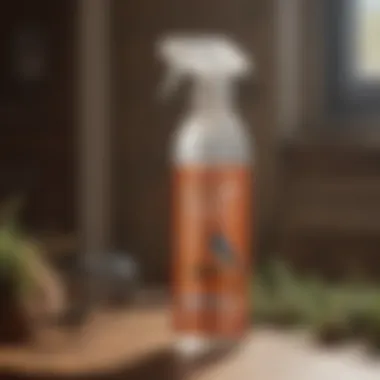Exploring Bird X Bird Repellent: Effectiveness and Mechanisms


Intro
Birds, while integral to our ecosystems, can sometimes become unwanted guests in our gardens and homes. Their habits and behaviors can lead to unsightly messes, noise, and potential property damage. To manage these challenges effectively, understanding the mechanisms behind bird repellents is essential. This article will untangle the various strategies available for repelling birds, concentrating not only on the active components involved but also on the ways these repellents interact with our environment and their overall effectiveness.
Recognizing the difference between synthetic and natural solutions can also make a notable difference in how you approach bird control, all while keeping in mind considerations for safety and ecological balance. Whether you're a homeowner wishing for a cleaner patio or an urban planner tasked with minimizing bird-related nuisances in public spaces, this guide aims to provide you with the knowledge you need.
Understanding Pests
Definition of Pests
Pests, more often than not, encompass a wide variety of organisms that are considered detrimental to human activity and comfort. In the context of birds, pests can refer to species that invade spaces where they are not wanted, interfering with our lives. Common examples include starlings, pigeons, and sparrows who can transform tidy gardens into messes or relentless noise.
Importance of Pest Identification
Identifying the specific bird species is crucial for effective pest management. Not all birds behave the same way; they have distinct feeding habits, nesting preferences, and environmental needs. Knowing what you’re dealing with helps tailor your approach, ensuring that you select the most appropriate repellent method. For instance, addressing the persistent presence of a flock of roosting pigeons around a balcony will differ considerably from tackling the occasional visit from a solitary sparrow.
Understanding your pests is the first step towards effective management. Identify, then act accordingly.
Prevention Techniques
Home and Garden Preventative Measures
Creating a space that discourages birds begins with the basic layout and maintenance of your garden. Here are some techniques to consider when seeking to make your space uninviting:
- Remove Food Sources: Ensure that pet food, or any outdoor waste is securely stored away.
- Use Physical Barriers: Install netting or bird spikes on ledges or high points where birds like to perch.
- Maintain Your Garden: Trim overgrown bushes; birds often seek nesting places in dense foliage.
Seasonal Prevention Tips
Seasonal changes can impact bird activity. During spring and summer, birds may be more prevalent as they seek nesting sites. In contrast, fall and winter may see birds flocking towards food sources. Adjust your preventative measures accordingly.
- In spring, monitor nests and discourage building too near your home.
- During winter, remove standing water to minimize congregations around those areas.
Eco-Friendly Pest Control Solutions
Overview of Sustainable Practices
Adopting eco-friendly pest control solutions not only benefits your immediate environment but also supports the broader ecological balance. Employing practices that are non-toxic reduces risks to other wildlife and pets. Here are some sustainable practices you can adopt:
- Utilize Birdhouses: Offering alternate nesting options can deter birds from taking over unwanted areas.
- Plant Strategically: Use plants that repel birds naturally while still maintaining the aesthetic of your space.
Natural Remedies and Their Effectiveness
Several natural remedies can be effective against bird nuisances. They often pose less risk compared to synthetic options and can be just as potent. Some of these include:
- Visual Deterrents: Hang reflective objects like old CDs to scare birds away.
- Sound Deterrents: Use sounds of predatory birds or distress signals from other birds to create an unsettling environment for the intruding species.
By implementing these strategies and applying knowledge from various facets of bird control, you can significantly reduce the disturbances caused by unwanted avian visitors while respecting the ecosystems around you.
Understanding Bird Repellents
Bird repellents play a vital role in managing human-bird interactions, especially in urban and suburban settings. Understanding this topic is essential for anyone looking to effectively deter birds without harming them or their environment. It highlights key aspects such as the variety of options available, their mechanisms of action, and the ecological implications of using such repellents. By focusing on these elements, homeowners can make informed decisions, ensuring their choices are both effective and environmentally friendly.
Definition and Purpose
In essence, bird repellents are substances or devices designed to deter birds from specific areas. The primary purpose of these products is to minimize the nuisances caused by birds, such as droppings, noise, and property damage. Whether one is trying to protect a garden, a building, or public spaces, understanding the definition of bird repellents helps uncover their significance in maintaining a harmonious coexistence with avian species.
Types of Bird Repellents
Different types of bird repellents cater to various needs and situations, providing a range of options for potential users. Here, we will explore three primary categories: chemical repellents, mechanical devices, and natural deterrents.
Chemical Repellents
Chemical repellents are substances that influence birds' behavior through taste or olfactory means. Generally, these products contain compounds that are unpleasant or irritating to birds, thus keeping them at bay. One key characteristic of chemical repellents is their immediacy in effect, often resulting in a rapid response once applied.
A particularly beneficial aspect of chemical repellents lies in their formulation. Many of them are designed to mimic the natural aversion birds have towards certain substances, making them an effective choice for those looking to tackle persistent problems quickly. These repellents get results but can also have drawbacks, such as potential harm to non-target species, which is a consideration for environmentally-conscious users.
Mechanical Devices


Mechanical devices are yet another category of bird repellents. These include physical barriers, such as nets or spikes, which physically block birds from accessing favored spots. Their main advantage is that they are non-toxic and provide a lasting solution without the need for chemicals. These devices continue working over time and do not rely on potential degradation like some chemical solutions.
However, they do require thoughtful placement and can occasionally alter the aesthetic appeal of a property, which some homeowners may find unattractive. Proper installation is crucial to ensure their effectiveness and avoidance of creating other hazards for wildlife.
Natural Deterrents
Natural deterrents offer an eco-friendly approach to bird management. They utilize organic materials or natural scents that birds find unpleasant. These might include substances like essential oils or specific plant extracts that can help keep birds away without harmful side effects.
A key characteristic of natural deterrents is their biodegradability. They tend to be less harmful to the environment compared to synthetic options. Their unique feature is their appeal to a growing audience that values sustainability. However, they may require more frequent applications and can be less effective in severe bird infestations, presenting a challenge for homeowners seeking lasting solutions.
"Using bird repellents thoughtfully can contribute to a balance between human and avian needs."
The Science Behind Bird Deterrents
Understanding the science behind bird detractors is essential for effectively managing bird-related issues. The mechanisms at play not only explain how these repellents work but also why some methods yield better results than others. When one digs into this sector, one can appreciate the intricacies and nuances that dictate bird behavior and their interactions with repellents. Factors like environmental conditions, types of birds, and the time of year can all influence how well a repellent performs, making it crucial for homeowners and urban planners to grasp these elements.
Behavioral Responses of Birds
Birds are creatures of habit and instinct, showing various responses when they encounter repellent materials or substances. Some birds might simply fly away at the sight of unfamiliar objects in their territory, while others may investigate or even adapt to changes over time. Understanding these behavioral patterns can help in choosing the right type of deterrent.
For instance, a device resembling a predator, such as an owl or hawk, may initially scare birds off but can lose effectiveness as they become accustomed to it. In contrast, chemical repellents that create discomfort without permanent harm might elicit a sustained reaction. This is where the elements of surprise and discomfort play into the effectiveness of a repellent.
Here are a few notable behavioral responses:
- Flight Response: Immediate retreat upon sighting a deterrent.
- Curiosity and Investigation: Birds may approach a new object cautiously but could develop tolerance over time.
- Change in Feeding Patterns: Birds might avoid areas treated with repellents, adjusting their behavior to feed elsewhere.
Understanding these responses allows for informed choices about which repellents to utilize and when to employ them, leading to better overall efficacy in deterring unwanted avian visitors.
Chemical Mechanisms
Chemical repellents work by introducing substances into the environment that disrupt a bird's sensory perceptions. These chemicals can target taste, smell, or even sight, prompting birds to avoid treated areas. For instance, certain chemical compounds can produce unpleasant sensations or flavors, deterring birds from feeding in those areas.
Key chemical mechanisms include:
- Taste Aversion: Certain repellents can make food taste bitter or otherwise unpalatable to birds, encouraging them to look for nourishment elsewhere.
- Olfactory Discomfort: Some substances release odors that birds find unpleasant, effectively driving them away from treated zones.
- Sensory Irritation: Chemicals that irritate a bird's eyes or skin can discourage them from entering an area.
Bird repellents that utilize such chemical mechanics can have varying levels of effectiveness, influenced by environmental factors such as wind and humidity, which can dilute or disperse the active elements. Regular monitoring and timely reapplication of these repellents can enhance their overall performance and help maintain their deterrent capabilities.
"The intricacies of bird behavior and the chemical responses to potential threats are fundamental for selecting effective bird deterrents."
Bird Bird Interaction: A Closer Look
When diving into the world of bird repellents, understanding the interactions among various repellent products becomes paramount. The concept of Bird X Bird interaction can shed light on how these products compete against one another, as well as how their active ingredients can overlap or complement each other. This examination isn’t just an academic endeavor; it has practical implications for those struggling with bird nuisances, from urban dwellers to agricultural professionals.
One of the core elements to consider here is the competition among repellents. In a marketplace crowded with solutions, it’s vital to identify which products can stand out. Not all repellents are created equal, and the effectiveness often hinges on the unique mechanisms they employ. For instance, while some might use sonic deterrents, others might rely on visual stimuli or even smells that birds find unpleasant.
This kind of competition can result in some products continuously improving their formulation in response to their rivals. As new technologies and methodologies are developed, it's crucial for consumers to stay informed about the latest offerings that may be better suited to their particular situation.
Competition Among Repellent Products
The competitive landscape of bird repellents is similar to a crowded marketplace where only the most effective products survive. Each repellent has specific strengths and weaknesses, often tied to its delivery method and the species of birds it targets. Here are a few key considerations:
- Effectiveness: Some repellents may work exceptionally well against specific species but fail against others. For example, a gel designed to deter pigeons might not be effective in discouraging sparrows.
- Ease of Use: Some products may require complex application processes, while others might be as simple as a spray. Homeowners juggling multiple responsibilities often lean towards ease of use.
- Cost: Price does factor in, but cheaper products aren’t always the best option. Sometimes investing a bit more upfront can yield long-term savings.
In a nutshell, knowing the track record of these repellents and how they perform against one another can guide homeowners in making informed choices that cater specifically to their environment.
Overlap in Active Ingredients
Discussing the overlap in active ingredients is another interesting facet of bird repellents. Different products often share similar components, which can sometimes muddle the lines of effectiveness. For example, a common active ingredient like methyl anthranilate can be found in both natural and synthetic formulations. This ingredient may deter a range of birds by affecting their sense of taste and smell.
Here are a few takeaways regarding the overlapping components:
- Synergistic Effects: In some cases, when combined with other ingredients, a shared active component can enhance overall effectiveness. For instance, layering repellents can lead to a broader spectrum of deterrence.
- Safety and Regulations: With overlapping ingredients, there are potential safety concerns. Homeowners should be attentive to how these components affect not only birds but also other non-target species, such as pets. It’s also wise to check regulatory guidelines to ensure compliance while using these products.
- Consumer Review and Feedback: Learning which common active ingredients receive praise or criticism from other users can provide insights too. Engaging with community forums or Reddit threads can lead to anecdotal evidence regarding product effectiveness.
"When choosing a bird repellent, it’s useful not just to look at individual efficacy, but at how well these products interact with each other in the environmental context."
In summary, the exploration of Bird X Bird Interaction serves multiple vital functions. It informs consumers about the competitive marketplace, the nuances of overlapping active ingredients, and the factors that play into making the most effective choice for managing bird-related concerns.


Evaluating Effectiveness
Evaluating the effectiveness of bird repellents is vital for anyone dealing with pesky bird problems, whether in urban settings or agricultural fields. This section focuses on discerning the actual impacts of different bird repellent methods. An understanding of effectiveness leaves no stone unturned, allowing property owners, urban planners, and ecologists to make informed decisions based on solid evidence.
Field Studies and Observations
Field studies serve as the backbone of assessing real-world effectiveness. Conducting observations in diverse environments helps in understanding how different repellents perform in practice rather than in theory. For instance, researchers might set up a series of bird feeders equipped with various repellents to gauge their effectiveness over time. Observers count the number of birds visiting each feeder and analyze the time it takes for birds to deter from feeding in the presence of these products.
Some considerations include:
- Location-based effectiveness: Urban repellents may perform well in city settings but could fail in rural areas due to differing bird species behavior.
- Environmental conditions: Weather, especially rain or wind, can affect how long a repellent lasts and its visibility to the birds.
- Duration of use: Are birds adapting over time? Some may initially stay away, but over time, they can become accustomed to the deterrents. Observational studies reveal trends that are critical in assessing long-term effectiveness.
"Understanding the behavior of local bird populations during studies is essential. It’s like learning their language, even if it’s through a series of pecks."
Laboratory Testing of Repellents
Laboratory testing is another critical layer in the evaluation of bird repellents. Here, the variables can be controlled, and precise measurements can be taken, giving researchers and consumers a clearer picture of efficacy. A common method involves offering birds a choice between regular feed and feed treated with various repellent substances. The data gathered can include:
- Consumption rates: This helps indicate how much the repellent disrupts feeding.
- Behavioral triggers: Researchers can note how soon birds react to a repellent, such as altering their approach or completely avoiding a certain area.
Laboratory environments allow replicable tests. This is crucial because it helps to standardize results across different studies. The conclusions drawn from these tests can make or break the credibility of a bird repellent. Knowing how a specific repellent performs in controlled settings arms homeowners with the confidence that it will work similarly in real situations, despite the unpredictability of nature.
In summary, both field studies and laboratory tests are indispensable in evaluating the effectiveness of bird repellents. They not only inform the product development process but also educate homeowners and stakeholders about what to expect when applying these solutions.
Natural Versus Synthetic Options
The distinction between natural and synthetic bird repellents is crucial in understanding their roles in environmental protection and efficacy. In this article, we will explore what each category entails, their benefits, and considerations to navigate the choices available for homeowners. Knowledge in this direction is especially useful for those aiming to limit bird-related inconveniences without compromising their communal spaces or ecological values.
Advantages of Natural Repellents
Natural repellents often emerge as the preferred choice for many. They utilize ingredients derived directly from nature and tend to be gentler on the environment. For example, products made with essential oils, such as peppermint or citronella, work effectively by creating odors that birds find off-putting. Here are some compelling reasons to consider natural options:
- Eco-Friendly: Natural repellents generally have a lower environmental footprint. They break down easily and usually have no harmful left-over effects on soil or plants.
- Safety for Humans and Pets: Unlike some synthetic chemicals, natural alternatives tend to be safer around children and pets, making them suitable for urban areas and homes.
- Non-Toxic Formulations: Many consumers are increasingly eco-conscious, seeking products that don’t introduce toxins into their homes or gardens. Natural repellents fit this bill, presenting a safer approach.
- Pleasant Scents: Some natural repellents can double as fragrances, infusing spaces with pleasant aromas while also deterring pests. This contrasts starkly with many chemically-based repellents, which can emit harsh or unpleasant smells.
"Choosing natural options often reflects a commitment to sustainability and health. It's a stance that resonates with the growing awareness of our impact on the environment."
Comparative Analysis with Synthetic Products
When assessing synthetic repellents, the landscape shifts considerably. These products often utilize chemical formulations specifically engineered to deter birds, frequently boasting rapid action and high efficacy. Here are several factors to consider when comparing them against their natural counterparts:
- Effectiveness: Synthetic repellents, such as methyl anthranilate-based options, are frequently considered more effective than natural products, especially for specific bird species.
- Longevity of Action: Many synthetic repellents boast longevity—staying effective longer in challenging weather conditions when compared to some natural alternatives which may require more frequent applications.
- Cost-Effectiveness: From a budgeting standpoint, synthetic options may sometimes be cheaper over time as they can require fewer applications due to their longer-lasting impact.
- Target Specificity: Synthetic repellents can offer greater accuracy in targeting specific bird populations, which can be particularly beneficial in agricultural settings. However, this can also lead to concerns regarding non-target species being affected.
Navigating the choice between natural and synthetic requires weighing the pros and cons carefully. Homeowners should consider not only the immediate effectiveness but also the long-term impact of their choices on the environment and their community.
Application Techniques
The effectiveness of any bird repellent hinges not only on its composition but also on how it is applied. Proper application techniques can significantly influence the repellent's performance. When discussing application methods, consideration for placement, timing, and frequency is paramount. This section encompasses those specifics, offering insights that can assist homeowners in maximizing their efforts against feathered nuisances.
Optimal Placement Strategies
When deploying bird repellents, placement is perhaps the most crucial factor to consider. It’s like putting a cherry on top of a sundae—a slight miscalculation can ruin the whole thing. The repellent should be positioned where birds primarily frequent. This often includes roofs, ledges, or any hanging structures near feeding areas.
Moreover, the height at which a repellent is placed matters. Several studies indicate that higher placements tend to be more effective, assuming the product is accessible and safe to apply. Think about the bird species in your area. Some species prefer nesting in lower areas, while others might flock to rooftops or eaves. Understanding their habits can lead to strategic placements that hinder access to those favored spots.
In addition to strategic height, consider surrounding elements. Placing repellents near bird feeders, gardens, or pools is often effective. These strategies create a deterrent effect right where the action is, discouraging visits without overly impacting the surrounding environment. If you're uncertain, trial and error—while keeping a close eye on the birds' behavior—can provide insight into optimal placement over time.
Timing and Frequency of Application
Timing in the application of bird repellents is just as significant as placement. Applying repellents at the wrong time can be akin to throwing out a net when there are no fish around. Ideally, you want to treat areas before birds take hold. At the beginning of seasonal migration, as well as during nesting periods, presents prime opportunities for application. For instance, early spring or late summer are critical times.
Additionally, monitoring rain or other weather conditions that may wash away applications is also key. In some cases, applying repellents just before heavy rainfalls is counterproductive, as the product can wash away, creating more work for the homeowner. Choosing calm, dry days for application enhances durability.
The frequency of reapplication varies depending on the product used. Chemical repellents often have specified intervals based on their active ingredients, while natural repellents may require more consistent applications. It is advisable to adhere closely to the manufacturer's instructions to ensure the repellent maintains efficacy.
Remember: Successful bird repelling is a continual effort, not merely a one-off project. Regularly evaluate effectiveness and adjust strategies accordingly.
In summary, the application techniques outlined here provide detailed insights into how to combat birds effectively. Through careful placement and timing, homeowners can optimize their strategies and successfully mitigate unwanted avian activity.


Safety Considerations
Understanding safety considerations is crucial when talking about bird repellents. Homeowners and managers alike want to find effective solutions without harming non-target species or disrupting the local ecosystem. The use of bird repellents should be a balanced approach, where effectiveness doesn’t come at an alarming cost to surrounding wildlife.
Impact on Non-Target Species
The impact on non-target species is a key factor in evaluating bird repellents. Many products are designed to deter specific bird types but might inadvertently affect other animals. For example, while using chemical repellents may keep pigeons away from your garden, they can also repel or harm beneficial insects and even small mammals.
Strong consideration must be given to:
- Ecosystem Balance: Maintaining the natural balance in your environment is essential. When non-target species suffer, it can lead to unintended consequences like increased pest populations.
- Behavioral Guidance: Ensuring that the chosen repellent targets only the intended species while having minimal impact on others requires careful product selection.
In a practical sense, evaluating an area before applying any repellent can offer insights. For instance, if you're in a region with a diverse bird population, it’s vital to consider how many other species might unintentionally be affected. Researching and opting for products classified as safe for various wildlife can alleviate some of the concerns here.
"Bird repellents can save your garden, but neglecting the surrounding fauna can lead to unforeseen complications in your ecosystem."
Regulatory Guidelines
Regulatory guidelines play a significant role in the application and safety of bird repellents. Through established regulations, authorities help ensure that products are both safe and effective. Homeowners should be familiar with local laws and any required licenses, which can vary by region.
Important aspects to consider include:
- Registered Products: Always look for repellents that are registered with local environmental protection agencies. These companies undergo rigorous testing to ensure they meet safety standards.
- Application Procedures: Familiarize yourself with the recommended procedures for applying bird repellents. Not all methods are suitable for every product. Following guidelines can help prevent overuse or improper application that might harm other species.
An additional consideration is the seasonal timing for using certain products. Some repellents are effective during specific periods within the life cycles of target species, so checking guidelines can lead you to a safer application strategy.
By staying informed about the regulations surrounding bird repellents, homeowners can make choices that are safer for themselves and their environment. This practice not only protects local wildlife but also bolsters the positive impact of the repellents used.
Case Studies of Successful Repellents
Understanding the practical application of bird repellents can hinge on real-world case studies, shedding light on how effective these solutions can be. These examples serve not just as success stories but also as learning tools for homeowners and community planners. By examining how various repellents have been utilized in different settings, we can grasp the nuances that contribute to their effectiveness. This section dives into notable cases where bird repellent strategies made a tangible difference, highlighting essential elements that ensure success, such as proper application methods and the importance of environment-specific solutions.
Urban Environments
In urban settings, the interplay between nature and human constructs can create unique challenges. Birds, attracted to city life due to abundant food and nesting opportunities, often transform common urban areas into their playground. As a case in point, many cities have successfully employed visual deterrents, such as reflective objects and predator decoys, to repel problematic bird species. An example of this is in Seattle, where local park departments incorporated shiny Mylar strips and plastic owls into their landscape around waterfronts.
- Effectiveness: Studies indicated a significant reduction in bird perching and nesting behaviors, confirming that these devices created an unwelcoming atmosphere.
- Community Involvement: This successful application relied heavily on community participation, where volunteers helped install and maintain these deterrents.
The moral here? When deploying repellents in urban. environments, understanding the local bird species and their behavioral patterns is crucial. This localized approach not only enhances efficacy but also fosters community engagement.
Agricultural Applications
Agriculture often finds itself at odds with avian populations, where crops become easy targets for hungry birds. Yet, there’s been a growing body of work illustrating how the right repellent strategies can safeguard harvests while minimizing ecological damage. Take, for instance, a grape farming cooperative in California. This co-op turned to auditory repellents, utilizing sound-based devices that mimic predator calls.
- Case Details: By deploying these sound devices throughout the fields during ripening season, they noted a marked decrease in bird activity, allowing for a greater yield of untouched grapes.
- Consideration of Impact: Farmers reported that these devices did not negatively affect non-target species, ensuring the ecological balance remained intact.
This particular case exemplifies how targeted auditory strategies can protect valuable crops while being mindful of the surrounding ecosystem. It reinforces the idea that a successful repellent strategy in agriculture isn’t just about the method used but also revolves around an understanding of the agricultural environment.
By looking at real cases, homeowners, urban planners, and farmers alike can glean valuable insights that lead to more effective bird control strategies.
Future Trends in Bird Repellent Technologies
Emerging trends in bird repellent technologies are becoming increasingly vital as communities strive to balance urbanization and wildlife management. The advent of new methods serves not only to minimize disturbances caused by birds but also aims to harmonize these solutions with environmental concerns. The next generation of bird repellents will likely witness innovations rooted in technology and ecology, combining effectiveness with sustainability. As homeowners and urban planners become more attentive to the ecological footprint of products, understanding these trends can help in making informed choices while maintaining a harmonious environment.
Innovative Solutions
Innovation in bird repellent technology is seeing a push towards smart solutions that leverage advanced materials and techniques. One recent approach includes the development of auditory repellents which use sound frequencies that are unpleasant to certain bird species. This method relies on mimicking natural predator calls, causing birds to feel threatened without causing them harm.
Additionally, pheromone-based repellents are gaining traction. These formulations use specific scents that disrupt the natural behavior of birds. By interfering with mating patterns or foraging instincts, these products serve as a means of population control without posing significant harm to the environment.
Furthermore, biodegradable materials and eco-friendly formulations are becoming a prominent trend. Homeowners are increasingly concerned about the long-term impact of synthetic chemicals, so manufacturers are pivoting towards natural alternatives that are just as effective, if not more. For example, clove oil and peppermint oil are gaining notice for their repellent properties, providing an effective deterrent against various bird species without adverse effects on other wildlife or plant life.
Sustainability and Environmental Impact
The pursuit of sustainable bird repellent solutions goes hand in hand with the technological trends emerging in the field. The focus now is not only on efficacy but also on minimizing ecological footprint. Traditional bird repellent methods often employ harsh chemicals that can harm non-target species and disrupt local ecosystems. A shift towards sustainable practices means considering the broader implications of bird management strategies.
"Sustainability is key in today's products. People want solutions that are effective but also respect nature."
This growing consciousness towards environmental impact is encouraging manufacturers to invest more in research focused on minimizing negative effects
Moreover, many of the newer repellents are being designed for longer-lasting effectiveness, which reduces the frequency of applications needed, thus conserving resources and preventing run-off that can lead to pollution.
In summary, the future of bird repellent technologies is leaning towards innovative, eco-conscious solutions that prioritize both efficacy and environmental stewardship. As technology evolves, so must our strategies in managing our avian neighbors, ensuring that we promote harmony between human activities and wildlife.



